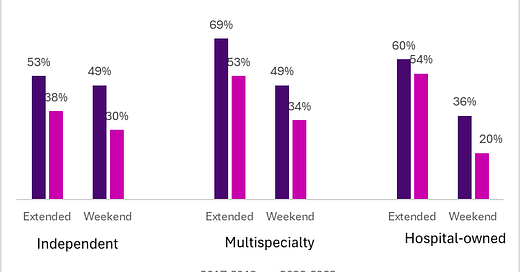Source: Mackwood, et al JAMA Health Forum February 7, 2025
My friends, whose primary care physicians have retired or moved, are having a hard time finding an open practice. I’ve heard similar experiences from colleagues and friends across the country. There are many causes for this. Primary care residency programs are not filling all of their slots, so there is a shortage of new primary care physicians. Walmart shuttered its 51 retail primary care practices, and Walgreens and Cigna took a $6 billion write-down on their investment in Village MD. Newly trained physicians are less willing to work extended hours, too.
Researchers report in JAMA Health Forum that fewer adult primary care practices offered visits during non-business hours or weekends in 2022-2023 compared to five years earlier. This decrease in primary care access is found in practices that are independent, those that are part of multispecialty groups, and those that are owned by hospitals or health systems.
The researchers noted no change in behavioral health integration, although they found an increase in electronic health record integration and more practices reported processes to care for patients with high needs. Chronic disease management was essentially flat.
Implications for employers:
Members of plans are likely to continue to find access for adult primary care outside of business hours a challenge.
Some practices might have found that with more people working flexible hours from home the demand for appointments outside of business hours declined. This does not help plan members with jobs that require them to be at the workplace during business hours.
The portion of primary care practices that are performing many of the elements of advanced primary care has not increased a lot, which could be a challenge for health plans based on more effective use of highly functional primary care teams.
The use of urgent care and digital solutions may grow in importance to ensure ongoing access to care.
Thanks for reading. You can find previous posts in the Employer Coverage archive
Please subscribe, “like” share this newsletter with friends and colleagues. Thanks!
Tomorrow: Many patients discontinue and reinitiate GLP-1 drugs





With the burden of college loans and medical school loans coupled with 3-4 years of residency training at $65k a year how could anyone afford to be a primary care physician? PAs and NPs have less debt and are paid more. If we want to fix this we need to change the compensation model